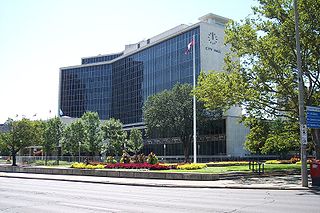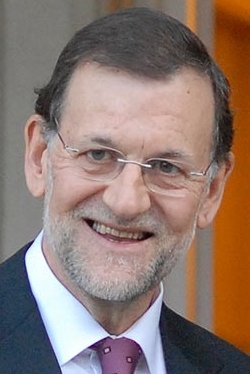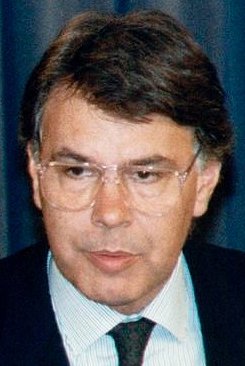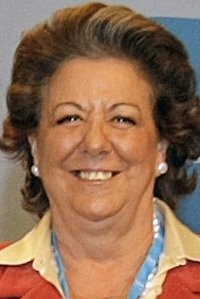Related Research Articles
Bart Maves is a politician in Ontario, Canada. He was a Progressive Conservative member of the Legislative Assembly of Ontario from 1995 to 2003. In 2010, he was elected as a Regional Councillor representing Niagara Falls for the Niagara Regional Council.
At large is a description for members of a governing body who are elected or appointed to represent a whole membership or population, rather than a subset. In multi-hierarchical bodies, the term rarely extends to a tier beneath the highest division. A contrast is implied, with certain electoral districts or narrower divisions. It can be given to the associated territory, if any, to denote its undivided nature, in a specific context. Unambiguous synonyms are the prefixes of cross-, all- or whole-, such as cross-membership, or all-state.

In the 2006 municipal elections in Ontario, voters in the province of Ontario, elected mayors, councillors, school board trustees and all other elected officials in all of Ontario's municipalities. These elections were regulated by the Municipal Elections Act of Ontario.

Politically, Hamilton is known for producing groundbreaking, colourful and left-wing politicians. Locally, though, the big political stories have included the controversial amalgamation of Hamilton with its suburbs in 2001, the destruction of green space around the Red Hill Valley to make way for the Red Hill Creek Expressway, and plans to build a Light Rail Transit line in the city.

The 2007 Spanish local elections were held on Sunday, 27 May 2007, to elect all 66,131 councillors in the 8,111 municipalities of Spain and all 1,038 seats in 38 provincial deputations. The elections were held simultaneously with regional elections in thirteen autonomous communities, as well as local elections in the three foral deputations of the Basque Country and the eleven island councils in the Balearic and Canary Islands.

The 2011 Spanish local elections were held on Sunday, 22 May 2011, to elect all 68,230 councillors in the 8,116 municipalities of Spain and all 1,040 seats in 38 provincial deputations. The elections were held simultaneously with regional elections in thirteen autonomous communities, as well as local elections in the three foral deputations of the Basque Country and the eleven island councils in the Balearic and Canary Islands.

The 2015 Spanish local elections were held on Sunday, 24 May 2015, to elect all 67,515 councillors in the 8,122 municipalities of Spain and all 1,040 seats in 38 provincial deputations. The elections were held simultaneously with regional elections in thirteen autonomous communities, as well as elections in the three foral deputations of the Basque Country, the four island councils in the Balearic Islands and the seven island cabildos in the Canary Islands.

The 1979 Madrid City Council election, also the 1979 Madrid municipal election, was held on Tuesday, 3 April 1979, to elect the 1st City Council of the municipality of Madrid. All 59 seats in the City Council were up for election. The election was held simultaneously with local elections all throughout Spain.

The 1983 Spanish local elections were held on Sunday, 8 May 1983, to elect all 67,505 councillors in the 7,781 municipalities of Spain and all 1,024 seats in 38 provincial deputations. The elections were held simultaneously with regional elections in thirteen autonomous communities, as well as local elections in the three foral deputations of the Basque Country and the ten island councils in the Balearic and Canary Islands.

The 1987 Spanish local elections were held on Wednesday, 10 June 1987, to elect all 65,577 councillors in the 8,062 municipalities of Spain and all 1,028 seats in 38 provincial deputations. The elections were held simultaneously with regional elections in thirteen autonomous communities, as well as local elections in the three foral deputations of the Basque Country, the ten island councils in the Balearic and Canary Islands and the 1987 European Parliament election.

The 2003 Barcelona City Council election, also the 2003 Barcelona municipal election, was held on Sunday, 25 May 2003, to elect the 7th City Council of the municipality of Barcelona. All 41 seats in the City Council were up for election. The election was held simultaneously with regional elections in thirteen autonomous communities and local elections all throughout Spain.

The 1991 Spanish local elections were held on Sunday, 26 May 1991, to elect all 66,308 councillors in the 8,060 municipalities of Spain and all 1,032 seats in 38 provincial deputations. The elections were held simultaneously with regional elections in thirteen autonomous communities, as well as local elections in the three foral deputations of the Basque Country and the ten island councils in the Balearic and Canary Islands.

The 1995 Spanish local elections were held on Sunday, 28 May 1995, to elect all 65,869 councillors in the 8,067 municipalities of Spain and all 1,034 seats in 38 provincial deputations. The elections were held simultaneously with regional elections in thirteen autonomous communities, as well as local elections in the three foral deputations of the Basque Country and the ten island councils in the Balearic and Canary Islands.

The 1999 Spanish local elections were held on Sunday, 13 June 1999, to elect all 65,201 councillors in the 8,104 municipalities of Spain and all 1,034 seats in 38 provincial deputations. The elections were held simultaneously with regional elections in thirteen autonomous communities, as well as local elections in the three foral deputations of the Basque Country, the ten island councils in the Balearic and Canary Islands and the 1999 European Parliament election.

The 2003 Spanish local elections were held on Sunday, 25 May 2003, to elect all 65,510 councillors in the 8,108 municipalities of Spain and all 1,036 seats in 38 provincial deputations. The elections were held simultaneously with regional elections in thirteen autonomous communities, as well as local elections in the three foral deputations of the Basque Country and the ten island councils in the Balearic and Canary Islands.

The 2019 Spanish local elections were held on Sunday, 26 May 2019, to elect all 66,979 councillors in the 8,131 municipalities of Spain and all 1,038 seats in 38 provincial deputations. The elections were held simultaneously with regional elections in twelve autonomous communities, as well as elections in the three foral deputations of the Basque Country, the four island councils in the Balearic Islands, the seven island cabildos in the Canary Islands and the European Parliament.

The 2003 Valencia City Council election, also the 2003 Valencia municipal election, was held on Sunday, 25 May 2003, to elect the 7th City Council of the municipality of Valencia. All 33 seats in the City Council were up for election. The election was held simultaneously with regional elections in thirteen autonomous communities and local elections all throughout Spain.
The 2018 Waterloo Region municipal elections were held on October 22, 2018 in the Regional Municipality of Waterloo, Ontario, Canada, to elect Waterloo Regional Council, the mayors and city councils of Cambridge, Kitchener, North Dumfries, Waterloo, Wellesley, Wilmot, and Woolwich, the Waterloo Region District School Board (Public), the Waterloo Catholic District School Board, and the regional members of Conseil Scolaire de District Catholiques Centre-Sud and Conseil Scolaire Viamonde (Public). The election was held in conjunction with the province wide 2018 municipal elections.

The 2023 Spanish local elections were held on Sunday, 28 May 2023, to elect all councillors in the municipalities of Spain and all 1,038 seats in 38 provincial deputations. The elections were held simultaneously with regional elections in twelve autonomous communities, as well as local elections in the three foral deputations of the Basque Country, the four island councils in the Balearic Islands and the seven island cabildos in the Canary Islands.
The 2022 municipal elections in Ontario were held on October 24, 2022.
References
- Corbett, Margaret; Hagar, Doug (September 2011), Representation on Municipal Councils in Ontario (Policy Brief 10), Brock University , retrieved 20 January 2015
- Courtney, John; Smith, David, eds. (2010). The Oxford Handbook of Canadian Politics. Oxford Handbooks in Politics & International Relations. Oxford University Press. ISBN 9780195335354. LCCN 2009023189.
- Mwanzia, Kithio (August 2013). "Modernizing governance in Niagara for the 21st century". Greater Niagara Chamber of Commerce. Archived from the original on 4 March 2016. Retrieved 6 January 2015.
- Rothblatt, Donald N.; Sancton, Andrew (1998). Metropolitan governance revisited: American/Canadian intergovernmental perspectives. Institute of Governmental Studies Press, University of California. ISBN 9780877723813.
- Starodubrovskaya, Irina; Slavgorodskaya, Margarita; Letunova, Tatiana; Mironova, Nina (2007), Regional Peculiarities of the Municipal Reform in the Period of Transition, Consortium for Economic Policy Research and Advice, SSRN 2109234
- White, Graham, ed. (1990). The Government and Politics of Ontario (4th ed.). Nelson Canada. ISBN 9780176034832.
- "Island municipalities, restructure studies and referenda". Islands Trust. Archived from the original on 16 June 2013. Retrieved 25 January 2015.
- Williams, Robert J. (November 2012). Interim Report: 2012 Ward Boundary Review (PDF) (Report). City of Markham . Retrieved 6 January 2015.
- "Orders of the day". Ontario Hansard. Legislative Assembly of Ontario. 11 June 1997. Retrieved 6 January 2015.
- "Council Business Plan". Regional Municipality of Niagara . Retrieved 6 January 2015.
- "Council". Regional Municipality of York . Retrieved 6 January 2015.
- "Enhancing the Tools for Problem Solving in Regions" (PDF). Regional District Task Force. Union of British Columbia Municipalities. January 2010. Retrieved 25 January 2015.
{{cite web}}: CS1 maint: others (link)